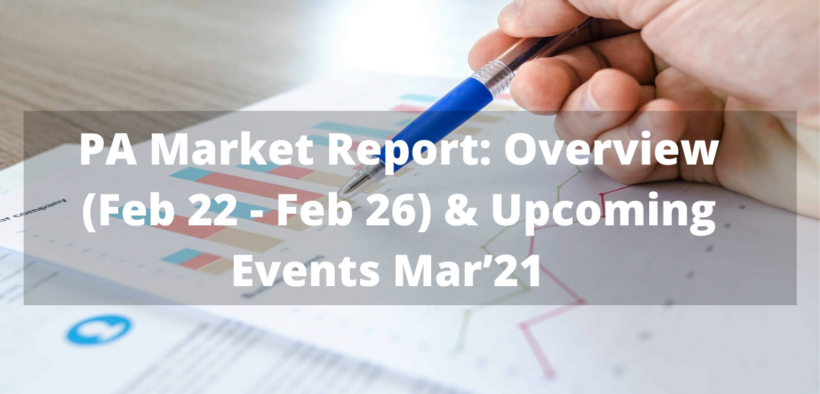PA Market Report: Overview (Feb 22 – Feb 26) & Upcoming Events Mar’2021
Share

PA Market report has overall updates of the approaching events which can impact the forex market. Let’s discover what happened last week.
Feb 22:
- A big survey took place about German and wider Eurozone economic conditions, involving historic correlation. 9,000 respondents from business enterprises were asked to rate on current business conditions and expectations for the next 6 months.
It will create an impact on the market upon release. As per May 2011, source changed series from a base year of 2000 to a base year of 2005, and as of Apr 2018, it changed series to include services. It’s a leading indicator of economic health. Any quick change to market conditions can impact upon future economic activity such as spending, hiring, and investment.
- ECB President (Nov 2019 – Nov 2027). Her speech has indicated interest rate clues regarding future monetary policy and traders attempt to decode it to predict any value change in market euros.
Feb 23:
- New Zealand retail sales data is extremely late compared to retail data from other countries. It’s the primary gauge of consumer spending and can largely impact the market and overall economic activity.
- The unemployment rate has largely affected the overall economic health. Unemployment is also a major consideration for the country’s monetary policy to get impacted.
- Federal Reserve Chairman Jerome Powell shared testimony with the public talking about heavy market volatility. As head of the central bank, which controls short term interest rates, he has more influence over the nation’s currency value than any other person. Traders followed up his public appearance to get clues about future monetary policy.
- Financial confidence is a leading indicator of consumer spending.
A survey held with 3,000 households respondents who were asked to rate the relative level of current and future economic conditions including labor availability, business conditions, and overall economic situation.
- BOC Governor Tiff Macklem came to speak at the Edmonton Chamber of Commerce & Calgary Chamber of Commerce. Traders attempted to decode his speech that indicates volatility & interest rate clues.
Feb 24:
- Reserve Bank of New Zealand, RBNZ recently released details on ways to achieve inflation targets. They are about to formulate and implement monetary policy during the next five years, and also shared how this implementation has been done since the last statement’s release. The information was useful as it revealed the bank’s view of economic conditions and inflation rates. These will influence the interest rate decisions.
- Reserve Bank of New Zealand, RBNZ released information containing how their decision influenced interest rates and commented about the economic conditions that influenced their decision. The most important discussion was on the economic outlook and it gave us clues on the outcome of future decisions.
- The rate decision is usually priced into the market, so it is not emphasized by the RBNZ Rate Statement as they focus on the future. Short term interest rates are the paramount factor in currency valuation. The RBNZ Governor decides where to set the rate after consulting senior bank staff and external advisers.
- The RBNZ press conference lasted about 30 minutes long. The press conference is webcasted on the RBNZ website real-time. The unscripted question & answer session revealed heavy market volatility hints. You can also find details on the overall economic outlook, inflation rates and clues regarding future monetary policy.
- Monetary policy report hearings happened where the BOE Governor and several MPC members testified on inflation rates and the economic outlook before Parliament’s Treasury Committee. Their public engagements left us with clues regarding future monetary policy.
- Fed Chair Powell shares testimony that reveals some unscripted hints about heavy market volatility.
- There is a change in the number of crude oil barrels in inventory by commercial firms. This is a US indicator.
It’s the primary measure of supply and demand. Any imbalances can change in production levels and price volatility.
Feb 25:
- Reserve Bank of New Zealand, RBNZ Governor testified before the Parliament Select Committee, in Wellington. His public engagements are often decoded as clues regarding future monetary policy & interest rates.
- Final ANZ Business Confidence forecasted using surveyed manufacturers, builders, retailers, agricultural firms, and service providers.
Survey responses taken from 1,500 businesses where the respondents were asked to rate the relative 12-month economic outlook. The report suggests that it is a leading indicator of economic health and any changes in this can impact economic activity such as spending, hiring, and investment.
- ‘Australian Bureau of Statistics’ reveals change in the total inflation-adjusted value of new capital expenditures formed by private businesses. It is an indicator of economic health, where traders believe that market conditions can be quickly affected by any changes in the investment levels or any future economic activity such as hiring, spending, and earnings.
- Bureau of Economic Analysis releases annualized change in the value of all goods and services produced by the economy. It’s the measure of economic activity and primarily measures the economy’s health.
Feb 26:
- Reserve Bank of New Zealand, RBNZ governor released information during speech delivery at the Canterbury Chamber of Commerce. The unscripted question & answer session revealed heavy market volatility hints. His public engagements are often decoded as clues regarding future monetary policy & interest rates.
- KOF Economic barometer increased above long-term average. This index, based on 219 economic indicators, is designed to predict the direction of economic conditions for the next 6 months. It is a combined reading of 219 economic indicators related to banking confidence, production, new orders, consumer confidence, exchange rate, money supply, interest rate spreads, stock market prices, and housing.
- The latest release of ISM-Chicago, Inc shows a survey of around 200 purchasing managers in Chicago who were asked to rate the relative level of business conditions including employment, production, new orders, prices, supplier deliveries, and inventories. It’s a leading indicator of economic health that is required by traders to determine market trends.
- G20 meetings are attended by finance ministers and central bankers from 20 industrialized nations including – Canada, Italy, France, Germany, Japan, the UK, and the US. At the end of the meeting, a formal statement is released with details on policy shifts and meeting objectives. G20 is an influential global policy where the initiatives can impact the currency markets.
Upcoming Events of next week March 2021 (Mar 1 – Mar 5)
Mar 1:
- Final Manufacturing PMI
- Manufacturing PMI
- ISM Manufacturing PMI
- ECB President Lagarde Speaks
Mar 2:
- RBA Rate Statement
- Cash Rate
- GDP m/m
Mar 3:
- GDP q/q
- Annual Budget Release
- ADP Non-Farm Employment Change
- ISM Services PMI
- Crude Oil Inventories
- MPC Member Tenreyro Speaks
Mar 4:
- RBNZ Gov Orr Speaks
- OPEC-JMMC Meetings
- Fed Chair Powell Speaks
Mar 5:
- Average Hourly Earnings m/m
- Non-Farm Employment Change
- Unemployment Rate
- Ivey PMI











